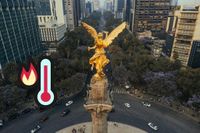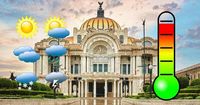In a notable development for Mexico City, the Environmental Commission of the Megalopolis announced the lifting of the third environmental contingency of the year on March 19, 2025, following a 24-hour evaluation period. The contingency was initially imposed as a response to a combination of factors: pro-taurine marches, a CNTE blockade in the Zócalo, and adverse weather conditions that led to a concerning spike in pollution levels.
With the contingency lifted, traffic restrictions eased for vehicles bearing green stickers and license plates ending in 1 and 2, allowing for a semblance of normalcy on the streets.
According to a report from the commission, "The conditions have improved, and we are hopeful about more stable weather ahead," indicating a positive outlook for air quality in the city.
Moving into March 20, the weather forecast shows a mostly clear day ahead, with temperatures expected to peak at 23 degrees Celsius. However, residents should prepare for potential rain, with a substantial 63% probability of precipitation calculated for the day. As noted by local meteorological services, cloud cover will remain at 89%, and gusts of wind could reach 33 kilometers per hour.
Even as the city braces for another potentially rainy day, the air quality remains a point of concern. The forecast includes a reminder from the Secretariat of Integral Risk Management and Civil Protection (SGIRPC), which warns of upcoming low temperatures. The secretary's representative stated, "Our focus is safety as these temperature drops can affect many, especially the vulnerable," urging communities to take precautions.
In the days that follow, temperatures in certain areas of the capital could drop to as low as six or four degrees Celsius, particularly impacting districts such as Álvaro Obregón, Cuajimalpa, and Milpa Alta, known for their cooler climates. Given these conditions, the SGIRPC has activated a yellow alert, advising residents to cover their mouths and noses when outside and hydrate adequately.
These weather fluctuations are becoming increasingly prevalent in Mexico City, leading some experts to connect the erratic patterns to the overarching impacts of climate change. This city, traditionally experiencing a more stable climate mix of temperate and moist conditions, has been increasingly subject to extreme weather events. As temperatures drift further from historical norms, with records indicating a highest temperature of 33.9 degrees Celsius and a lowest of -10 degrees, it's clear that adaptation strategies are necessary.
This year alone, three environmental contingencies have already been declared, echoing a trend seen in previous years where summer months, particularly May, typically come with higher pollution levels. Last year, the Secretariat of Environment (Sedema) reported 11 separate occurrences of environmental contingencies, with most attributed to insufficient atmospheric mixing accompanying seasonal changes.
The city has also seen its climate narrative shift; summers are now frequently characterized by extreme heat coupled with heavy rains, as local residents often experience the stark contrast between heatwaves and sudden downpours. Public sensitivity around these issues is rising, and local environmental initiatives are working more closely with communities to foster awareness about water management and air quality.
In conclusion, the day ahead in Mexico City promises mild sunshine and moderate temperatures, but amidst its environmental struggles, vigilance remains critical. While March 20 will present an opportunity for outdoor activities under clearer skies, the climate variability serves as a stark reminder of how pressing collective action towards sustainability is in a metropolitan landscape facing threats from climate change.








